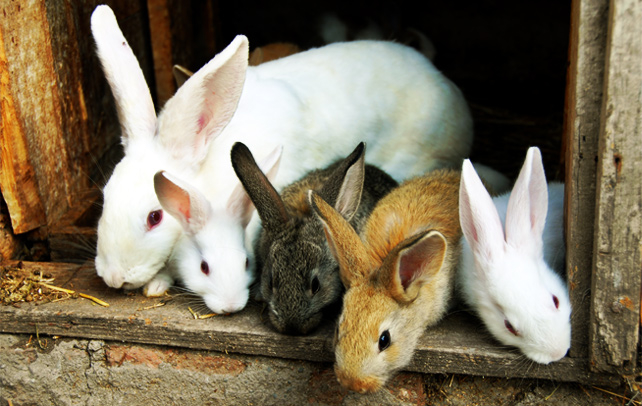Fun Facts About Rabbits

Though in reality you won’t find rabbits wearing waist-coats or speaking like human beings or having watches nor will you fall down a rabbit hole to usher in amazingly great new world, yet there are many interesting facts about rabbits which are particularly amusing to learn. Rabbits (or colloquially, bunnies) are small mammals in the family Leporidae of the order Lagomorpha, found in several parts of the world. There are eight different genera in the family classified as rabbits, including the European rabbit (Oryctolagus cuniculus), cottontail rabbits (genus Sylvilagus; 13 species), and the Amami rabbit (Pentalagus furnessi, an endangered species on Amami Ōshima, Japan). There are many other species of rabbit, and these, along with pikas and hares, make up the order Lagomorpha. The male is called a buck and the female is called a doe; a young rabbit is a kitten or kit. Read this article to come across all the interesting and amazing information on rabbits.
Fast Facts
Scientific Name: Oryctolagus cuniculus
Kingdom: Animalia
Phylum: Chordata
Class: Mammalia
Order: Lagomorpha
Family: Leporidae
Genera: Seven (Pentalagus, Bunolagus, Nesolagus, Romerolagus, Brachylagus, Sylvilagus, Oryctolagus and Poelagus).
Length: 20 cm to 50 cm
Weight: 0.4 to 2 kg
Ears: 10 cm (4 in)
Number of Teeth: 28, with 6 incisors (4 on top and 2 on bottom)
Smallest Species: Pygmy Rabbit
Colors: Shades of brown, gray and buff
Diet: Grass, forbs and leafy weeds
Natural Habitat: Meadows, woods, forests and grasslands
Lifespan: 4 to 20 years
Age of Maturity: 3-4 months
Gestation Period: 28 to 31 days
Fun Facts About Rabbits
- Rabbits are herbivores and eat carrots, vegetables, tree barks and herbs.
- Rabbits have long sensitive ears, which can turn in any direction and can also help in regulating their temperature.
- Rabbits are not rodents, they are lagomorphs.
- When the doe (female rabbit) gives birth, her babies are collectively referred to as a litter.
- The gestation period for a rabbit averages 31 days.
- Rabbits have 28 teeth, which never stop growing.
- Rabbits can be litter trained.
- A rabbit can live as long as 10 years.
- Bunnies are weaned for 8 weeks.
- Rabbits weigh between 2 to 11 pounds.
- Rabbits can purr similar to a cat.
- Domesticated rabbits are born without fur.
- Domesticated rabbits eyes do not open until they are about 2 weeks old.
- Rabbits cannot vomit.
- Rabbits need hay to assist the digestive system and prevent fur balls in their stomach.
- Rabbits have very good memory.
- Rabbits live in groups, in underground burrows. They like dry, well-drained slopes on field edges, grassland, woodland and dunes. They live in open country where predators like foxes and birds of prey are easily spotted. One rabbit is always on guard when they are feeding. When danger approaches, the guard stamps its feet and the whole colony bolts down their burrows.
- They use their keen senses to hear or smell danger. One of their amazing features is that they can move their ears independent of each other. It’s the rabbit’s own built-in radar system.
- Mothers typically only feed their kits about 5 minutes a day.
- Rabbit meat is lower in fat, cholesterol and calories than chicken, pork and beef.
- Rabbit meat is white meat.
- Rabbits require about four hours of exercise daily. They can suffer from osteoporosis if they don’t get enough exercise.
- Rabbit droppings make an excellent garden fertilizer.
- A 4 pound rabbit will drink as much water as a 20 pound dog.
- Bunnies love to chew.
- Rabbits do not hibernate.
- Rabbits can jump 36″ and higher.
- Rabbits can suffer heat stroke.
- Rabbits can see behind them, but have blind spot in front of their face.
- When rabbits are happy, they will jump and twist, which is called a binky.
- Rabbits can start breeding as early as 3-4 months of age.
- Rabbits can have babies at age 6 months old. They can have 20 to 40 babies a year. Litters of 3 to 7 young are produced, at five-week intervals, from January to late summer.
- Predators can literally scare a rabbit to death.
- Does pull fur when pregnant to assist in the building of their nest.
- Rabbits can have false pregnancies.
- Rabbits groom themselves.
- Domestic rabbits cannot breed with wild rabbits.
- The only place a rabbit sweats is through the pads on its feet.
- Rabbits eat their own night droppings called cecotropes.
- In 1845, the 1st rabbit organization was formed in Great Britain and is called Metropolitan Rabbit Club. The first United States rabbit organization is American Rabbit Breeders Association (ARBA), which started in 1910 and still in business today.









